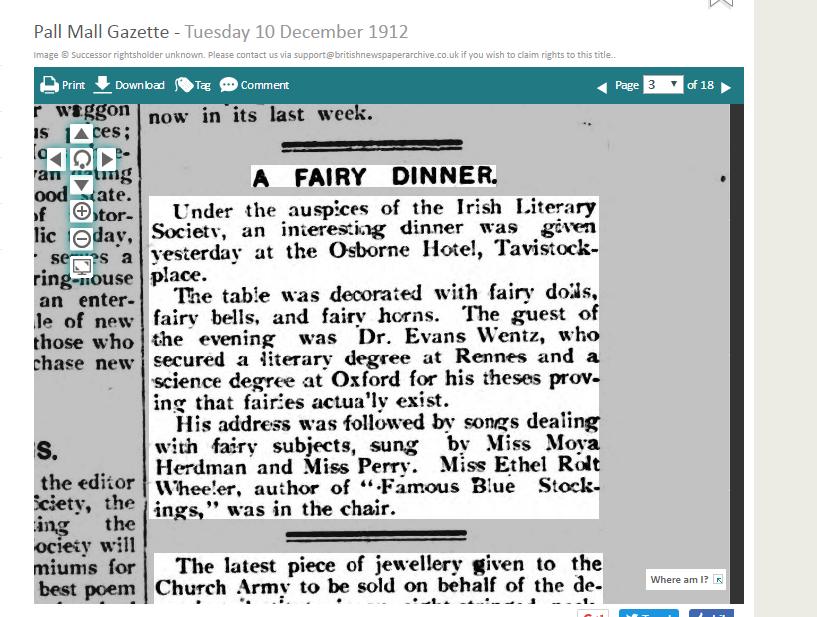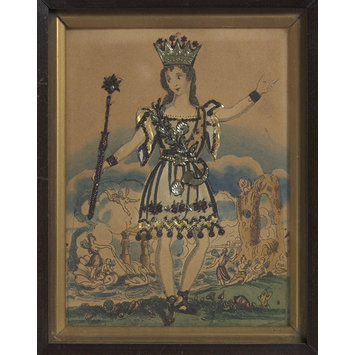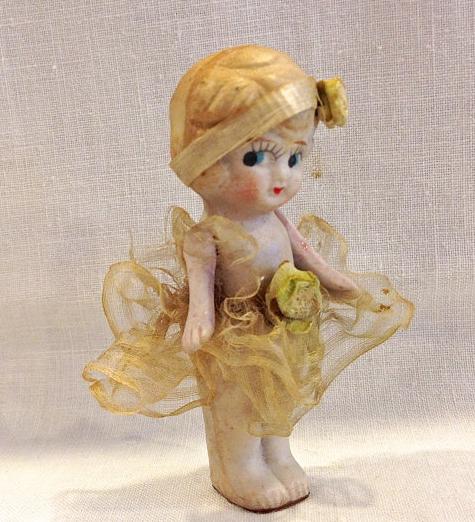Immortal Meals #33: Fairy Feast 1912 June 11, 2017
Author: Beach Combing | in : Modern , trackbackOh to have been there… Walter Yeeling Evans Wentz was an American eccentric and mystic who from 1908 to 1911 studied British, Irish and Breton fairies. Readers may have come across his curious The Fairy Faith in Celtic Countries, brought out in November 1911, the single most bizarre book every published by Oxford University Press – and that is saying something. Evans Wentz gently explained to readers how fairies were real and how only the school, the church and railways had made them invisible to us moderns. In 1912 and 1913 Evans Wentz was still in London and enjoying a well deserved victory lap, being invited to dinners, telling hushed audiences about his ‘psychical theory’ of the fey, and dreaming of the future – he would soon be off to chase gigolos in Monte Carlo and gurus in the Himalayas. The British newspapers of the time detail some of these soirees and this is the one that Beach would most have liked to have sat in at: a themed meeting of the Irish Literary Society.
Under the auspices of the Irish Literary Society, an interesting dinner was given yesterday at the Osbourne Hotel, Tavistock-place. The table was decorated with fairy dolls, fairy bells and fairy horns.
Wth! Particularly curious about the fairy horns…
The guest of the evening was Dr. Evans Wentz, who secured a literary degree at Oxford for his theses [sic] proving that fairies actually exist.
His address was followed by songs dealing with fairy subjects, sung by Miss Moya Herdman and Miss Perry. Miss Ethel Rolt Wheeler author of ‘Famous Blue Stockings’, was in the chair.
Sounds like an evening that would be difficult to forget. Is it too much to hope that someone kept a souvenir fairy doll, fairy bell and fairy horn? Drbeachcombing at yahoo Dot com
Leif writes, 30 Jun 2017:
Dr. Beachcombing expresses curiosity concerning the fairy horns decorating the tables
at the Irish Literary Society dinner for Mr. Evans Wentz. Based on the passage which follows, it is reasonable to assume they were drinking horns.
But this begs the question. Exactly what does on eat at a ‘fairy-themed’ dinner?
Cheers,
Leif
Briggs, Katharine M. and Tongue, Ruth L., editors. Folktales of England. Chicago: University of Chicago. 1965.
Pixy Fair
Collected by Ruth L. Tongue from a farmer’s daughter on the Quantock Hills, South West, in Somerset in 1960.
The central motif is F352, “Theft of a cup (drinking horn) from the fairies.” Legends of cup thefts ar given in Thomas Keightley, The Fairy Mythology (London, 1860), pp. 283-85, 292-93, the best known being “The Luck of Eden Hall.” E. S. Hartland in The Science of Fairy Tales (London, 1891), pp. 48-50, chap. 6, “Robberies from Fairyland,” gives many similar traditions, as well as examples of fairy gold (F342.1) turning to coal or leaves. Christiansen classifies the type as 6045, “Drinking Cup Stolen from the Fairies” in Thd Migratory Legends, and prints two texts in Folktales of Norway, a companion volume in this series, Nos. 52a, 52C, “The Drinking Horn Stolen from the Huldre-Folk,” See also W. A. Craigie, Scandinavian FolkLore (London, 1896), p. 132, “One-Leg and the Stolen Goblet.”
In West Quantock dialect, well-illustrated in this tale, the word for lame, applied to a horse, is “scramble-footed”; to a man, “crippled”; and to a woman, “hobbled.”
‘ave ‘ee yeard ’bout th’ old man that come whoame frorn Markut? He wuz comin’ up road loike when ‘cr zaw th’ girt Pixy Vair, an’ on one o’ the starls there he zaw a gold mug vull up the top o’ gold pieees. Zo ‘er thart to ‘isself, “Ef I d’ grab ‘ee I shall ‘ave ’nuff money vur rest of me loife.”
Zo with no more ado he d’ gallop right on dru Pixy Vair, laying hold to mug as her went, and went on whoame as vast as pony’s legs ‘ood carry ‘n. Highly delighted with proize he took ‘n to bed vor zafe-keeping. Weil, next marnin’ vust thing he looks at was his mug– but ‘t ‘ad gone. And what do ‘ee think– arl there was was a girt twoad-stool. And when ‘ee goes out t’ get pony ‘e finds ’tis scramblc-footed, an’ zo ’twas ‘er was like it the rest of ‘er days.
Beach replies: I’d wondered about musical horns, but I admit they are rather less useful at a meal.
Invisible, 30 Jun 2017:
I presume that the fairy horns of the Evans-Wentz orgy were supposed to represent the Horn of Oberon.
Just as lady fairies had their starry magic wands and crowns, in popular lore, Oberon’s symbol was the horn, but was it a drinking horn or a musical horn? And is it from Shakespeare or earlier? Here’s a tinsel print of Madam Vestris playing Oberon (no wings!). No horn in sight.
Some sample titles reflecting the symbol:
Oberon; or, the Charmed horn. A romantic fairy tale, in two acts, 1826
A FAIRY NIGHT’S DREAM OR THE HORN OF OBERON Katharine Elise Chapman, 1900
Oberon’s horn: a book of fairy tales, 1861
The following excerpt is from The Boke of Duke Huon of Burdeaux, edited by Sir Sidney Lee, 1884
THE HORN OF OBERON.
This horn was made by four fairies in the isle of Cephallonia; one (Gloriande) endowed it with the power of curing by its blast all manner of sickness; a second (Translyne) with the power of satisfying hunger and thirst; a third (Margale) with the power ‘that whosoever heard this horn, though he were never so poor and feeble by sickness, he should have such joy in his heart that he should sing and dance ’; a fourth fairy (Lempatrix) gave the horn the gift of forcing him who heard it to come at the pleasure of him who blew it (p. 66). When this ‘ rich horn of ivory’ is bestowed by Oberon on Huon, its_only virtue mentioned is that it brings a hundred thousand men to the aid of him who blows it, if—and the condition is all-important—there is genuine need of help (pp. 77, 78).
Musical instruments having the same property as that with which the third fairy endowed the horn of Oberon, viz. of making every one who heard it to dance, nnlens rolens, are common to the folk-tales of all Europe. For examples, the magic pipe in our old English tale of The Friar and the Bag/, and the violin in its German counterpart (in Grimm), Dav: Jude im Darn, and the harp in the Icelandic Herauds ok Bosi Saga; and akin to these is the pipe of the Piper of Hamelin, which not only drew all the rats into the Wcser but drew all the children into a mountain. In the Icelandic saga, which, according to ‘Mr. Baring-Gould, rests on a mythological foundation, a harp occurs which belongs to one Sigurd. ‘ Bosi slays Sigurd, puts on his skin and clothes, and taking the harp goes in this disguise to the banquet-hall of King Godmund, where his true love is about to be married to another man. He plays the harp, and the knives and plates, the tables and stools, then the guests, and lastly the monarch himself are set to dancing. He keeps them capering till they are too exhausted to move a limb, then he casts the bride over his shoulder and makes off.“ In Croker’s collection of Irish Fairy Legends one Maurice Connor is said to have been able by playing a certain tune on his bagpipes, to make old and young, lame and lazy, “up and at it,” till they fell down from sheer exhaustion.—The fourth virtue of Oberon’s horn, that of bringing a hundred thousand men to the aid of him who blows
it is also found in the horn that drew crowds which was presented by the little man in red to one of three soldiers journeying together, according to the German story of ‘The Nose’ (in Grimm); and also in the bagpipe of the young hero of a Slav tale in M. Dozon’s French collection (No. 2), which when played upon calls up any number of armed soldiers
As for the fairy bells, I regret to say that they were a staple of Spiritualist seances and seem to have been like a glockenspiel or xylophone, to be tinkled in a shivery manner by the visiting spirits. But in the case of fairy party favors, they may have simply been something like silvered papier-mache Christmas bells. The fairy dolls are likely to have also come from the Christmas box since the Christmas fairy in wax or china, dressed in gauze and silver paper, was a stock late Victorian and Edwardian Christmas ornament. Here are some fairy doll examples:
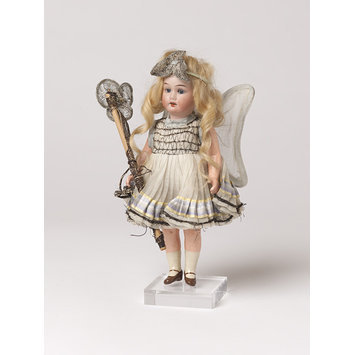
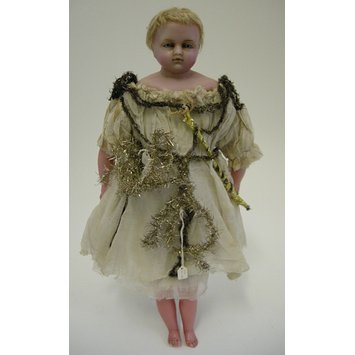
There are suggestions in women’s publications that tiny China dolls, either jointed, Kewpie, or the Frozen Charlotte type, be dressed as fairies for party favors. Instructions were also given for making stick fairy dolls or paper fairy dolls, like this one:
Another Christmas Tree Ornament is the Dancing Fairy. Get a “scrap picture” that represents a pretty face with arms and waist. Paste this in the middle of a circular skirt made by taking a strip of tarlatan or tissue paper three inches wide and a yard long. Plait or gather this so closely that it spread out all round like a gauzy skirt. Spangle it with euchre stars or bits of gilt paper, and add a loop at the back, by which to hang the doll to the tree.
The Puritan, Volumes 7-8, 1895
This is an excerpt from a 1914 article on making homemade holiday decorations:
The dolls can be dressed in crepe paper, but the wings should be transparent and delicate. After the doll is dressed and the wings firmly sewed on, bend the arms and legs to give the required action to the body. Fairies always, like angels, have golden hair, so when you buy a doll’s head for a Christmas tree fairy, buy a blond head.
And one more:
Dancing Christmas fairies always enhance the children’s delight in the Christmas tree, and once made can be used year after year. Buy up to a dozen or more of 5 and 10 cent dolls and to add to the variety have among the number some Japanese and colored dolls. Dress these to represent fairies in bright hues of spangled gauze, tarlatan or tissue paper and liberally sprinkle their hair and garments with diamond dust powder. Each doll should be provided with a dainty pair of fairy wings made from spangled tissue paper and fastened to the body by means of concealed wires. These wires should be coiled to obtain motion in the wings and nothing better can be used than the fine spiral coils that come out of worn out, wire stitched brooms. The least motion will set this spiral to quivering, causing the wings to move as if in flight. In like manner use the spiral wire to attach the dolls in hovering positions over and around the tree. The effect is magical; every footstep causes jar enough to start the dolls dancing and circling above and around the tree, as if the invisible fairies of the air had come down to join the Christmas glee. Woman’s Home Companion.
Plain Dealer [Cleveland, OH] 17 December 1899: p. 5
This is an example of a 5 or a 10-cent doll
So there you have it, short of the specifications for the horn (I suspect they were something like a cone-shaped papier-mache candy container or even a cornucopia) you could easily duplicate the fairy party decorations at home!

